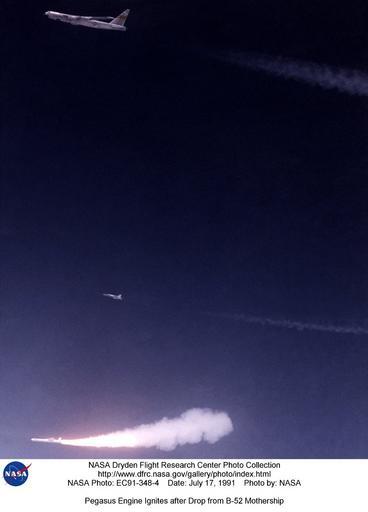MAKE A MEME
View Large Image

| View Original: | Pegasus_Engine_Ignites_after_Drop_from_B-52_Mothership_DVIDS718121.jpg (1104x1536) | |||
| Download: | Original | Medium | Small | Thumb |
| Courtesy of: | commons.wikimedia.org | More Like This | ||
| Keywords: Pegasus Engine Ignites after Drop from B-52 Mothership DVIDS718121.jpg en Against the midnight blue of a high-altitude sky Orbital Sciences' Pegasus winged rocket booster ignites after being dropped from NASA's B-52 mothership on a July 1991 flight A NASA chase plane for the flight is also visible above the rocket and below the B-52 Pegasus is an air-launched space booster produced by Orbital Sciences Corporation and Hercules Aerospace Company initially; later Alliant Tech Systems to provide small satellite users with a cost-effective flexible and reliable method for placing payloads into low earth orbit Pegasus has been used to launch a number of satellites and the PHYSX experiment That experiment consisted of a smooth glove installed on the first-stage delta wing of the Pegasus The glove was used to gather data at speeds of up to Mach 8 and at altitudes approaching 200 000 feet The flight took place on October 22 1998 The PHYSX experiment focused on determining where boundary-layer transition occurs on the glove and on identifying the flow mechanism causing transition over the glove Data from this flight-research effort included temperature heat transfer pressure measurements airflow and trajectory reconstruction Hypersonic flight-research programs are an approach to validate design methods for hypersonic vehicles those that fly more than five times the speed of sound or Mach 5 Dryden Flight Research Center Edwards California provided overall management of the glove experiment glove design and buildup Dryden also was responsible for conducting the flight tests Langley Research Center Hampton Virginia was responsible for the design of the aerodynamic glove as well as development of sensor and instrumentation systems for the glove Other participating NASA centers included Ames Research Center Mountain View California; Goddard Space Flight Center Greenbelt Maryland; and Kennedy Space Center Florida Orbital Sciences Corporation Dulles Virginia is the manufacturer of the Pegasus vehicle while Vandenberg Air Force Base served as a pre-launch assembly facility for the launch that included the PHYSX experiment NASA used data from Pegasus launches to obtain considerable data on aerodynamics By conducting experiments in a piggyback mode on Pegasus some critical and secondary design and development issues were addressed at hypersonic speeds The vehicle was also used to develop hypersonic flight instrumentation and test techniques NASA's B-52 carrier-launch vehicle was used to get the Pegasus airborne during six launches from 1990 to 1994 Thereafter an Orbital Sciences L-1011 aircraft launched the Pegasus The Pegasus launch vehicle itself has a 400- to 600-pound payload capacity in a 61-cubic-foot payload space at the front of the vehicle The vehicle is capable of placing a payload into low earth orbit This vehicle is 49 feet long and 50 inches in diameter It has a wing span of 22 feet There is also a Pegasus XL vehicle that was introduced in 1994 Dryden has never launched one of these vehicles but they have greater thrust and are 56 feet long NASA Identifier NIX-EC91-348-4 2009-09-23 Glenn Research Center https //www dvidshub net/image/718121 718121 2012-10-10 18 28 WASHINGTON DC US PD-USGov Vandenberg Air Force Base Langley Research Center Images from DoD uploaded by Fæ | ||||